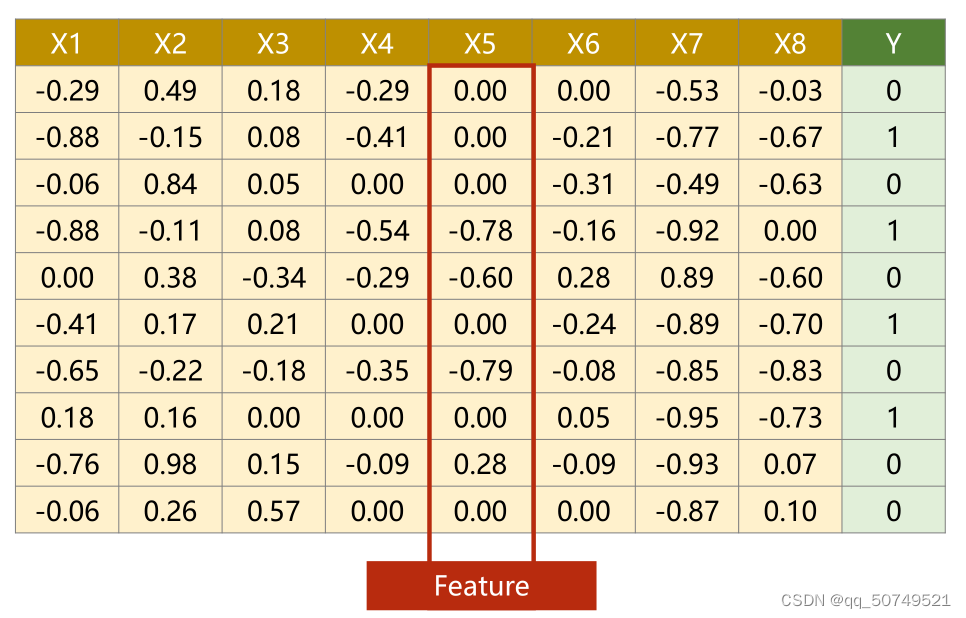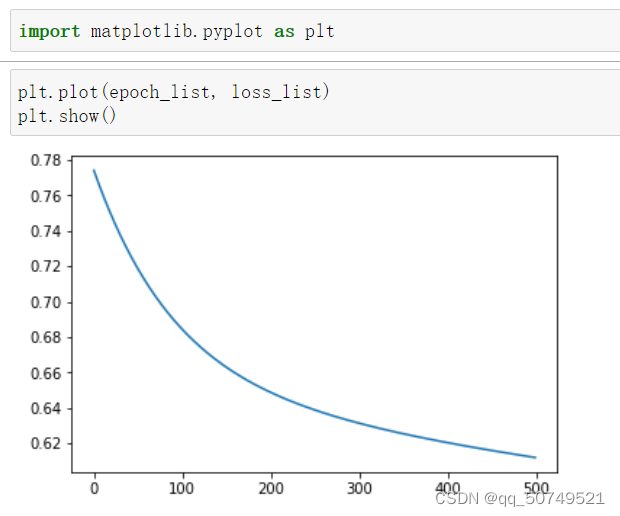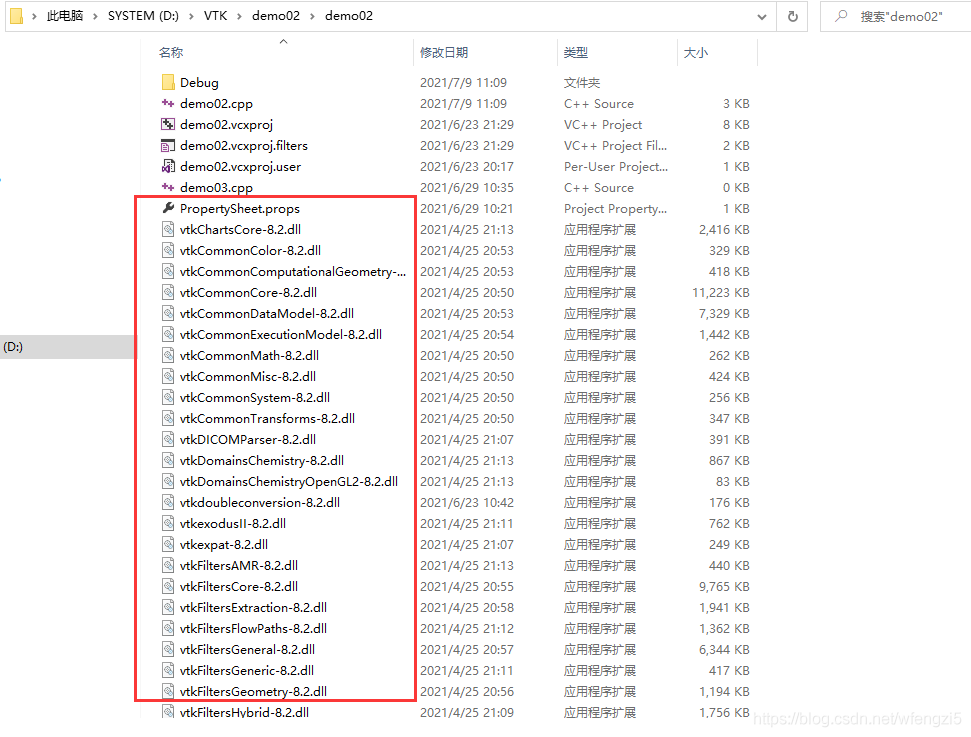当前位置:网站首页>Pytorch study notes 7 - processing input of multi-dimensional features
Pytorch study notes 7 - processing input of multi-dimensional features
2022-07-31 06:32:00 【qq_50749521】
Pytorch学习笔记7——处理多维特征的输入
This is a dataset for diabetes classification.
每一行代表一个样本Sample,Each column is called a featurefeature.shared here10个样本,每个样本有8个特征.Y为对应标签.
Dataset preparation is just that:取出前8列得到X矩阵作为input,最后1列得到Ymatrix as labels.
i表示样本索引,nRepresents the feature index.Each eigenvalue is multiplied by a weight.
The result must be a scalar.
对于N样本处理,在torch里继承的moduleFunctions are all vectorized functions,比如sigmoidIt is calculated by vector,The same operation is performed on each element in the matrix.
The weights and biases are the same here.z1 z2 … zn都是标量,组成一个向量.
这样,Matrix operations can be further combined.X矩阵变为N * 8的,w矩阵变成8 * 1的,b矩阵变成N * 1的,Through this vectorized calculation, we can have the ability of parallel computing,提高了运行速度.

这样,在LinearThe linear layer we have to do is putInput(N, 8)转为output(N, 1).
torch.nn.Linear(input_dim, output_dim), 其中input_dim表示输入数据的特征维度, output_dim表示输出数据的特征维度,这里分别为8,1:
self.linear1 = torch.nn.Linear(8, 1)

损失计算:
四步走:
- Prepare Dataset
- Design model using class
- construct loss and optimizer
- Training cycle(forward, backward, update)
#Preapre Dataset
import numpy as np
xy = np.loadtxt('F:\ASR-source\Dataset\diabetes.csv.gz', delimiter = ',', dtype = np.float32)
x_data = torch.from_numpy(xy[:,:-1])#Take out all but the last columnyoutside the front8列
y_data = torch.from_numpy(xy[:,[-1]])#取出最后一列
print(x_data.shape)
print(y_data.shape)
输出:
torch.Size([759, 8])
torch.Size([759, 1])
#Design model using class
import torch
class Model(torch.nn.Module):
def __init__(self):
super(Model, self).__init__()
self.linear1 = torch.nn.Linear(8, 6)
self.linear2 = torch.nn.Linear(6, 4)
self.linear3 = torch.nn.Linear(4, 1)
self.relu = torch.nn.ReLU()
self.sigmoid = torch.nn.Sigmoid()
def forward(self, x):
x = self.relu(self.linear1(x))
x = self.relu(self.linear2(x))
x = self.sigmoid(self.linear3(x))
return x
#construc loss and optimizer
criterion = torch.nn.BCELoss(reduction='mean')
optimizer = torch.optim.SGD(mymodel.parameters(), lr = 0.01)
#training cycle
epoch_list = []
loss_list = []
for epoch in range(500):
y_pred = mymodel(x_data) #得到预测值
loss = criterion(y_pred, y_data) #计算损失
optimizer.zero_grad() #梯度归0
loss.backward() #反向传播更新梯度
optimizer.step()#更新权重、偏置
print('='*10, 'Epoch = ', epoch+1, '='*10)
print(loss.item())
epoch_list.append(epoch)
loss_list.append(loss.item())

The spatial transformation of the actual species is non-linear.We often use multiple layers of linear transformations,通过找到最优的权重,把他们组合起来,to simulate nonlinear transformations,So the essence of neural network is to find nonlinear spatial transformation.
所以,LinearHere we can go first8D->6D, 6D->4D, 4D->1D,Step by step to reduce the dimensionality.
当然,You can also go up in dimension, 8DChange to higher dimensions24D,further lower.This determines the complexity of the network,As for how to get it,That's the problem with hyperparameter search,See who performs better on the dataset.
中间层数越多,神经元越多,模型的学习能力越强.但并不是越多越好,Too much learning ability will result in learning noisy values of the data,出现过拟合现象,Such models do not generalize well.
class Model(torch.nn.Module):
def __init__(self):
super(Model, self).__init__()
self.linear1 = torch.nn.Linear(8, 6)
self.linear2 = torch.nn.Linear(6, 4)
self.linear3 = torch.nn.Linear(4, 1)
self.sigmoid = torch.nn.Sigmoid()
def forward(self, x):
x = self.sigmoid(self.linear1(x))
x = self.sigmoid(self.linear2(x))
x = self.sigmoid(self.linear3(x))
return x

We generally still use itReLU激活,但需要注意的是,ReLUThe input value is less than0都会输出0,This makes it impossible to compute gradients,So activation in the last layer must not be usedReLU,可以改成Sigmoid.如下:
class Model(torch.nn.Module):
def __init__(self):
super(Model, self).__init__()
self.linear1 = torch.nn.Linear(8, 6)
self.linear2 = torch.nn.Linear(6, 4)
self.linear3 = torch.nn.Linear(4, 1)
self.relu = torch.nn.ReLU()
self.sigmoid = torch.nn.Sigmoid()
def forward(self, x):
x = self.relu(self.linear1(x))
x = self.relu(self.linear2(x))
x = self.sigmoid(self.linear3(x))#Note that the last step cannot be usedrelu,Avoid failing to compute gradients
return x

End
边栏推荐
- 虚拟机查看端口号进程
- opencv之访问图像像素的三种方法
- Cholesterol-PEG-DBCO Cholesterol-Polyethylene Glycol-Diphenylcyclooctyne Chemical Reagent
- cv2.resize()是反的
- MW:3400 4-Arm PEG-DSPE 四臂-聚乙二醇-磷脂一种饱和的18碳磷脂
- ROS之service编程的学习和理解
- 钉钉H5微应用免登鉴权
- IDEA控制台不能输入信息的解决方法
- After unicloud is released, the applet prompts that the connection to the local debugging service failed. Please check whether the client and the host are under the same local area network.
- Picture-in-Picture API in the browser
猜你喜欢

CAS:474922-22-0 Maleimide-PEG-DSPE 磷脂-聚乙二醇-马来酰亚胺简述

mPEG-DSPE 178744-28-0 甲氧基-聚乙二醇-磷脂酰乙醇胺线性PEG磷脂

Cholesterol-PEG-Thiol CLS-PEG-SH 胆固醇-聚乙二醇-巯基

Nmap的下载与安装

The content of the wangeditor editor is transferred to the background server for storage

PyTorch学习笔记08——加载数据集

Fluorescein-PEG-DSPE Phospholipid-Polyethylene Glycol-Fluorescein Fluorescent Phospholipid PEG Derivatives

JS写一段代码,判断一个字符串中出现次数最多的字符串,并统计出现的次数JS

ROS之service编程的学习和理解

VTK环境配置
随机推荐
Software Testing Interview Questions 2021
钉钉H5微应用免登鉴权
ERROR Error: No module factory availabl at Object.PROJECT_CONFIG_JSON_NOT_VALID_OR_NOT_EXIST ‘Error
自己设置的私密文件,在哪找
IDEA控制台不能输入信息的解决方法
计算图像数据集均值和方差
opencv之图像二值化处理
VS2017 connects to MYSQL
ROS之service传输图片
2021-09-30
ROS之service编程的学习和理解
VTK:Could not locate vtkTextRenderer object.
数据分析之SQL面试真题
softmax函数详解
变分自编码器VAE实现MNIST数据集生成by Pytorch
DSPE-PEG-COOH CAS:1403744-37-5 磷脂-聚乙二醇-羧基脂质PEG共轭物
这些数组技巧,我爱了
Shell/Vim related list
WeChat applet source code acquisition and decompilation method
MySQL master-slave switching steps